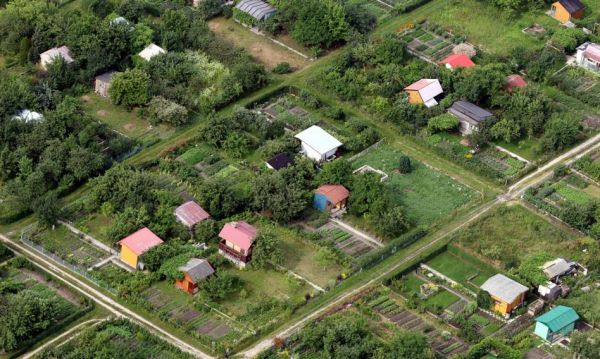With the arrival of spring, interest in allotment gardens has increased again. However, there are still many more people interested in a piece of greenery in the city than there are free plots. The rates entered in advertisements in the largest Polish cities exceed even PLN 300,000. We explain how to become an allotment gardener much cheaper.

The allotment gardens are seeing more activity with each warmer day. As the flower beds are getting greener, interest in having your own patch of greenery in the city is growing. As reading the announcements regarding the transfer of rights to use allotment gardens shows, the rates, especially in the largest cities, are still going crazy. The phones at the garden boards are also ringing off the hook.
– Traditionally, the first warm weekends, which we already had in March, resulted in more and more calls from people willing to take over plots. In the absence of any free plots, we only put people on the waiting lists, which are getting bigger – says Andrzej Potera from the board of ROD “Kotwiczna” in Szczecin.
As Mieczysław Dobroszkowiak from the board of ROD Poziomka in Wrocław adds, vacant plots appear most often after the season – in autumn and winter. In spring, calls from people willing to become allotment holders predominate. However, according to estimates by the Polish Allotment Holders Association, this is only 1 to 2 percent of all plots. What is more, vacant plots are usually located in unattractive locations, and in addition, they are unattractive in themselves, because they are neglected.
Prices of ROD plots – up to several hundred thousand zlotys for the right of use
So how do you become an allotment gardener as quickly as possible? By buying the right to use it. A review of advertising portals shows that, as in previous years, there are fewer offers than before the outbreak of the COVID-19 pandemic.
In this case, however, you need to have a few thousand zlotys set aside, and if you are interested in a plot of land in a large city, in a good location and in good condition, prices range from several dozen to even several hundred thousand zlotys.
Just five years ago, before the pandemic boom in allotment gardens, the right to use a plot of land, even in the largest Polish cities, could be purchased for several thousand złoty. Although individual offers for the transfer of the right to an allotment garden for around PLN 20,000 can be found on advertising websites , PLN 30,000 is currently the threshold from which the rates dictated for the least-maintained plots of land with an area of around 3 ares start.
As it results from the advertisements posted on OLX, in order to gain the right to a plot of land located in Warsaw, one must expect to spend at least PLN 30,000. Gardens with well-kept houses, plants or electricity and an area of approx. 3-4 ares are usually valued at approx. PLN 70-80,000.
Among the offers, however, you can find 4-are plots for sale for over PLN 100,000. In such a case, along with the right to the plot, a heated modular house of several dozen meters is offered, with a separate toilet and even a kitchen. Such plots are most often offered as “all-year-round”, although according to the law, it is not possible to live in allotment gardens.
The highest amount recorded in the advertisement concerning the sale of the right to an allotment garden in the capital amounted to PLN 330,000. The most expensive offers, however, do not concern flimsy gazebos, lawns and planted flower beds, but most often so-called “year-round” houses with utilities connected, but located on the areas of allotment gardens.
The right of use is not ownership
Let us remember, however, that it does not matter whether the offer amounts to a dozen or several hundred thousand zlotys, whether it concerns an empty plot or a plot with a two-story “year-round” house, whether the title says “for sale” or “for giving away”, in each case the subject of the transaction is the right of use, not the right of ownership.
The ROD areas are the property of the State Treasury, local government units or garden associations. The “purchase and sale” agreement of the plot with the previous owner is nothing more than the transfer of the lease right to the given area, which means a change of the party of the previous agreement concluded with the ROD.
How to acquire the right to a plot of land from another allotment holder?
A notarial deed is the most popular way to become an allotment holder. The amount for which we acquire the right to use is the remuneration for the previous allotment holder for the plants, devices or gazebo located on the plot.
After the agreement is drawn up, an application must be submitted to the board of the given ROD, which must approve the transfer of rights to the plot. The garden association has two months to do so. However, it may refuse to approve the transfer of rights to the plot. It then designates another person to whom such a transfer may take place. The person selected by the ROD board must submit a statement of readiness to pay the allotment holder the amount indicated in the earlier application.
Tax on the sale of rights to a plot of land
When selling the right to use a plot of land, we sell only the plants, equipment and facilities located on it, not the area itself. The amount received for selling the rights to the plot of land is nothing more than income for which personal income tax must be paid. However, according to art. 10 sec. 1 item 8 of the Personal Income Tax Act, it is income from the sale of other items for consideration, which is subject to taxation under general rules only if it was achieved within six months of acquiring the individual items.
Therefore, if the equipment on the plot of land for which we receive remuneration when selling the rights to the plot of land was created more than six months from the date of obtaining the income, there is no obligation to pay tax.
How to become an allotment gardener?
The easiest and cheapest way to become an allotment holder and obtain a small plot of land in the city or on its outskirts is to take over the right of use from another family member. However, this is a luxury of the few.
The right of use can also be acquired by applying to one of over 4,600 allotment gardens with around 900,000 plots. However, there is very little free land.
In addition, their pool is systematically decreasing. As reported by representatives of the district boards of the PZD, traditionally with spring, phones ringing from people willing to become allotment gardeners. For five years, i.e. since the pandemic spring of 2020, there have been more calls than in previous years, and the waiting lists have significantly lengthened.
According to data from the Lublin district board of the PZD, the waiting lists in the allotment gardens there have grown to an average of about 70 people. This means that the waiting time to acquire the right of use can be years.
Purchase of land from the ROD management
In the case of signing a plot lease agreement, there is no need to go to a notary. The allotment holder obtains the rights to the plot on the day the agreement is signed. Such an agreement with the allotment holder can also be concluded by the spouse of the allotment holder, who requests the establishment of rights to the plot jointly with his spouse, provided that he does not already have the right to another plot.
Acquisition of a plot of land after a deceased spouse
The plot is not subject to inheritance. After the death of the allotment holder, the ROD board becomes its administrator. According to the PZD statute, the estate includes plantings, facilities located on the plot and objects – e.g. a gazebo.
The priority in claiming rights to use the plot after the death of the allotment holder is given to the spouse, who may file a declaration within 6 months of the death of the spouse that they wish to exercise this right. Only if they do not file such an application, the claim to establish the right to the plot passes to other close persons – e.g. children and grandchildren, who have 3 months to file an application.
In order to save time on procedures, it is worth acquiring rights to the plot while your spouse is still alive. In this case, you need to submit an application to the ROD board, after which a plot lease agreement is signed.
Purchase of a plot of land by a person close to the deceased
In the event of the death of an unmarried allotment holder, the right to the allotment may be acquired by close persons – children, grandchildren, great-grandchildren, parents, grandparents, siblings, children of siblings or persons in an adoption relationship with the allotment holder.
In order to acquire the right to a plot of land after a deceased person, an application for a plot lease agreement must be submitted to the ROD board. This must be done no later than 6 months from the date of the allotment holder's death. A death certificate must be attached to the agreement. Then, after at least 6 months from the death of the allotment holder, an agreement is signed with the new lessee of the plot. In the event of several entitled parties applying, the court will decide on the establishment of the right to the plot, which will take into account, among other things, whether the person used the plot together with the deceased.
Purchasing an allotment garden – costs and fees
When acquiring rights to a plot of land, one must remember about the fees to be paid, i.e. the entry fee and the so-called investment fee.
The entry fee, according to the statute of the Polish Allotment Gardeners' Association, cannot exceed the value of the garden infrastructure located on the plot. In turn, the investment fee can amount to a maximum of 25 percent of the minimum wage. Currently, the investment fee is a maximum of PLN 1,167.
Plot usage fees
For the use of the plot, we will have to pay a so-called garden fee once a year. Its amount depends on the square footage of the plot. It can also be based on a lump sum increased depending on the square footage. It usually includes participation costs, management costs (usually a few or a dozen groszy per square meter), maintaining order and cleanliness, purchasing electricity, public-law purposes (e.g. waste removal), renovations, maintenance, economic and investment purposes.
ROD plot insurance
Allotment gardens are particularly vulnerable to weather conditions. In addition, there is theft, to which allotment gardens, due to the often poor protection of the area, are particularly susceptible.
In such situations, it is worth considering allotment garden insurance, which will limit losses related to fire or robbery. The analysis of Bankier.pl conducted by Aldona Derdziak shows that there are only a few policies available on the market that will cover allotment gardens and their equipment or movables. There is, however, a detail: the protection applies primarily to summer houses, and not to the plot understood as a recreational area.
Importantly, if we are interested in protecting our allotment garden against theft, insurance companies require it to be properly secured.






